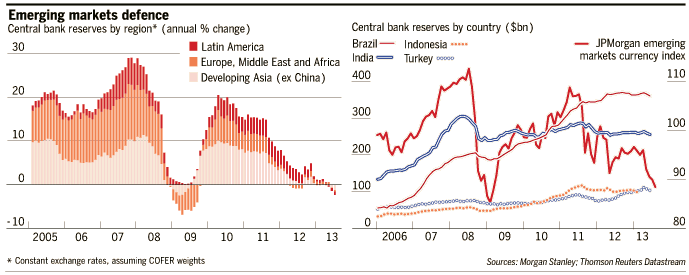Emerging Market Economies Indicate Economic Slowdown for Global Economy
Post on: 12 Август, 2015 No Comment

Economic conditions in the U.S. economy may be improving slightly, but the global economy is on the verge of witnessing an economic slowdown—and a possible recession. Key indicators are flashing red signals and warning of trouble ahead for the global economy.
In these pages, I have written rigorously about how the main economic hubs of the global economy are witnessing an economic slowdown, with the eurozone and Japan in an outright recession. The Chinese economy is slowing down, and emerging market economies are now starting to show concerns, as their troubles are quickly brewing.
This week, the central bank of South Korea cut its interest rates to 2.5% from 2.75%. The main reason for this cut in rates was deteriorating exports. In March, industrial output for the country declined 2.6% from February—the biggest decline in a year.
Similarly, central banks from countries like India, Taiwan, and the Philippines may do the same and cut interest rates to boost their exports and economies.
Emerging market economies export to developed nations in the global economy. If these emerging markets experience an economic slowdown, it will mean that demand is weak in the developed countries.
Other key indicators, like industrial metal prices, are reaffirming the economic slowdown.
Special: An Important Message from Michael Lombardi:
I’ve identified six time-proven indicators that now all point to a stock market crash in 2015. You can see my latest video, Six Time-Proven Indicators Now All Pointing to a 2015 Stock Market Crash, which spells out why we’re headed for a crash and what you can do to protect yourself and even profit from it, when you click here now.
Consider the price of aluminum, a metal used in many different technologies. On the London Metal Exchange (LME), aluminum traded for about $2,100 per ton at the beginning of 2013. Fast-forward to today, and the price has declined almost 12% to around $1,850 per ton. (Source: London Metal Exchange web site, last accessed May 9, 2013.)
Likewise, other industrial metals, such as copper, are signaling an economic slowdown or even a recession ahead in the global economy. The price of copper has declined roughly 13% since the beginning of the year.
The decline in corporate earnings and gross domestic product (GDP) in the U.S. may be one thing, but I am worried about higher unemployment and more misery for Americans who are already struggling.
The recession we witnessed in 2008 was a result of a U.S. domestic banking system on the cusp of collapse because of our housing bust. But this time around, the problems are coming from the global economy. Be very careful if you are heavily involved in the stock market.
What He Said:
“I see a deal when it’s a deal. And right now there’s a good ‘for sale’ sign flashing on gold bullion and gold producer shares. In fact, after peaking at the $690 an ounce level earlier this year, gold could be a bargain at its current price of around $650 per ounce. As a reader, you are undoubtedly aware of my negative stance on the general stock market and the U.S. economy. As the economic problems continue to brew in the U.S. as these problems develop into others, and as they are finally exposed, what other investment but gold will worldwide investors turn to?” Michael Lombardi in Profit Confidential. March 14, 2007. Gold bullion was trading under $300.00 an ounce when Michael first started recommending gold-related investments.














